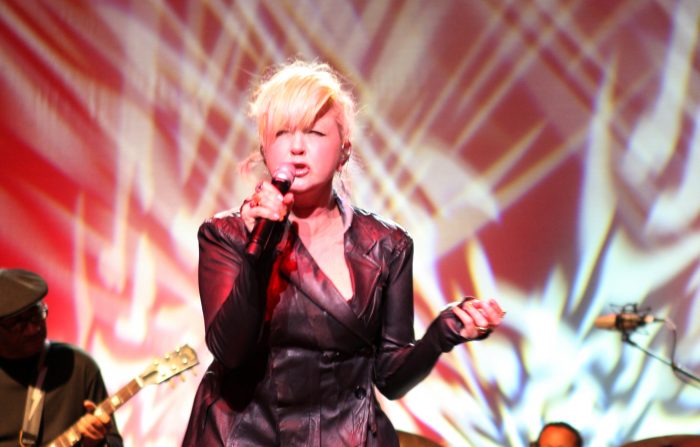“You with the sad eyes
Don’t be discouraged
Oh I realize
It’s hard to take courage
In a world full of people
You can lose sight of it all
And the darkness inside you
Can make you feel so small
But I see your true colors
Shining through
I see your true colors
And that’s why I love you
So don’t be afraid to let them show
Your true colors
True colors are beautiful
Like a rainbow”
~ Cyndi Lauper
~
This morning, my Labradoodle puppy Emma snuck upstairs again.
We have a fence at the base of the stairs to keep her on the main floor, but my husband and I went to the forbidden upstairs and left her all alone. I know in her puppy mind, any trouble is worth the risk to be with her “pack,” so she figured out how to get around the fence and fly upstairs. She wildly zipped from room to room in a frenetic, leaping, crazy-dog dance. She grabbed the first sock she could find and just kept running.
Stephen M.R. Covey wrote, “We judge ourselves by our intentions and others by their behavior.”
If someone saw Emma this morning, in this moment, they might think all sorts of bad things about her, about her breed, about her trainer (me). They might offer advice, shake their head, be glad they don’t have a high energy dog like this, and even be happy we aren’t neighbors. These assumptions may grow quickly and smoothly, enlarging into a Facebook post, describing how ridiculously out of control Labradoodles are, how untrainable, wild, and possibly dangerous. And then this opinion falls into the swirling swill of social media—and there it goes, as it does.
Or, maybe, you will listen to me compassionately with an open mind as I describe our sweet, furry girl, and tell you how much she wants to be with us all the time. I can tell you that generations of breeding taught her to stay with her pack for survival and safety. This is in direct opposition to our training: to entertain herself, to be alone. We can’t always be with her, so teaching her that she can be separate and safe will calm her anxiety when we do need to leave.
But this morning, we are upstairs and she is not. And the excitement of the forbidden is overriding any training. So up the stairs she goes.
Please, hear me out. You see, I think her leaping around wildly is her nervous system on fire. Stress hormones like cortisol and adrenaline are flowing through her veins, and the huge cognitive dissonance of being with her beloved pack and disappointing us is overwhelming. If I yell at her and put her in her crate, I am not training her and getting a change in behavior; I am creating a painful pattern of nervous system upset, trouble, and separation—and eventually, she will be out and with her pack again. That is, until we surely do this pattern all over again. And it is likely the next time we are upstairs and she isn’t, there will be escalation—more anger from me, more fear from her. I don’t want that.
So, I give her a command she can accomplish, even in this upset state. “Sit, Emma.” She lays down. I laugh. “Oh, good dog, to lay down!” See that there, where I ignore the behavior I don’t want and celebrate what she is doing? I feel a bit of shift happening in both of our nervous systems’ survival, anger, blame/shame cycles.
She doesn’t move. She has my sock in her mouth. I get down low with her. I look at the sock, not in her eyes. Her nervous system must be calming itself; her face has softened, but the sock is still in her mouth. I know that holding something in their mouth is a dog’s way to calm themselves, like a baby with a pacifier.
Softly now, “Good girl. Lay down, Emma. Can you leave it? Leave it…”
We have been working on “leave it,” the command to move away. I gently put my hand on the sock and wait. She drops it. She is quiet now, for a minute, then she starts getting wound up again. Maybe she is remembering that she is still upstairs where she isn’t supposed to be, and we are about to do the same wild, crazy dog thing.
I see her moving toward the sock basket when I say, “Leave it?”
She moves her head away and I praise her. I am trying to finish the laundry, but she needs my support right now.
We walk downstairs and I give her a command to sit—she gets a treat and I decide to finish the laundry later. She lays down to take a nap. This calm girl—who is doing her puppy best to figure out life in our home—deserves my compassion, my positivity, my care. If I do this, she can show her true colors.
Yesterday, a friend described a nasty relationship breakup during his town’s lockdown and the worst flames of COVID-19. It was painful, and he described his ex as “showing his true colors.”
I wondered about true colors. I think this might be the key to our national healing.
Turning to a wise songstress gave me some answers this morning.
When we are hurting, we see with defensive eyes.
We see others’ hateful behaviors, and we come to the conclusion that their attitudes, opinions, and actions are the truth, their deepest character, their true colors—but is this true?
We are far from our deepest, truest, best selves when we are blinded by our unhealed trauma. When we are riding the invisible but destructive waves of survival response, we act from a nervous system under attack, not a calm, reasoning, and compassionate place. Certainly not a place of growth and healing.
Seventy million people voted strongly to support the current administration in this country. Can we look at their hurt—openly? Can we see their trauma and fear, compassionately? Can we look at their anger without judgement?
Many are choosing to blame, to analyze, to defend, and to live in self-righteous judgement. But these are the tools of separation, of “othering” and racism, and the parents of generational suffering and trauma. These repetitive and destructive cycles may feel right, and they are certainly patterns with deep cultural ruts in the journey of our American experience. But this is the easy, rutted, road to hell.
It takes concentrated, devoted hard work to rise out of those ruts and encourage others to do the same.
Can we let go of the tidy and terrible labels: “Trumper,” “MAGAt,” or “Snowflake?”
Can we give each other a breath, some room, and some compassion as we all muddle through our collective suffering?
In the last few months, there have been so many references to the loaded colors blue and red. I watched a video yesterday describing two warring gangs in California whose colors are blue and red, and I thought of this whole warring country, one siding with the color of the open sky, and the other with the color of a loving heart, and both are the colors of an American flag.
How do we show our true colors and see the true colors of others to end this raging war?
My girl Cyndi understands.
“You can lose sight of it all
And the darkness inside you
Can make you feel so small”
But we are in this together, we can heal our collective pain. We can care for our own brains, hearts, and bodies, call out poor behavior when it happens, celebrate little movements toward the light, and hold ourselves and each other to a higher, brighter standard.
And then, we can do as Cyndi sings,
“But I see your true colors
Shining through,
I see your true colors
And that’s why I love you.”







Read 8 comments and reply